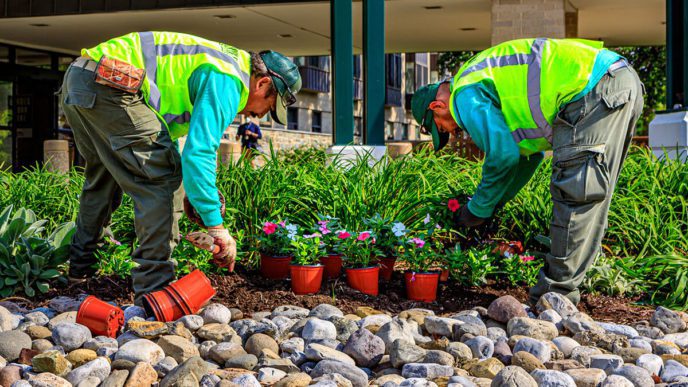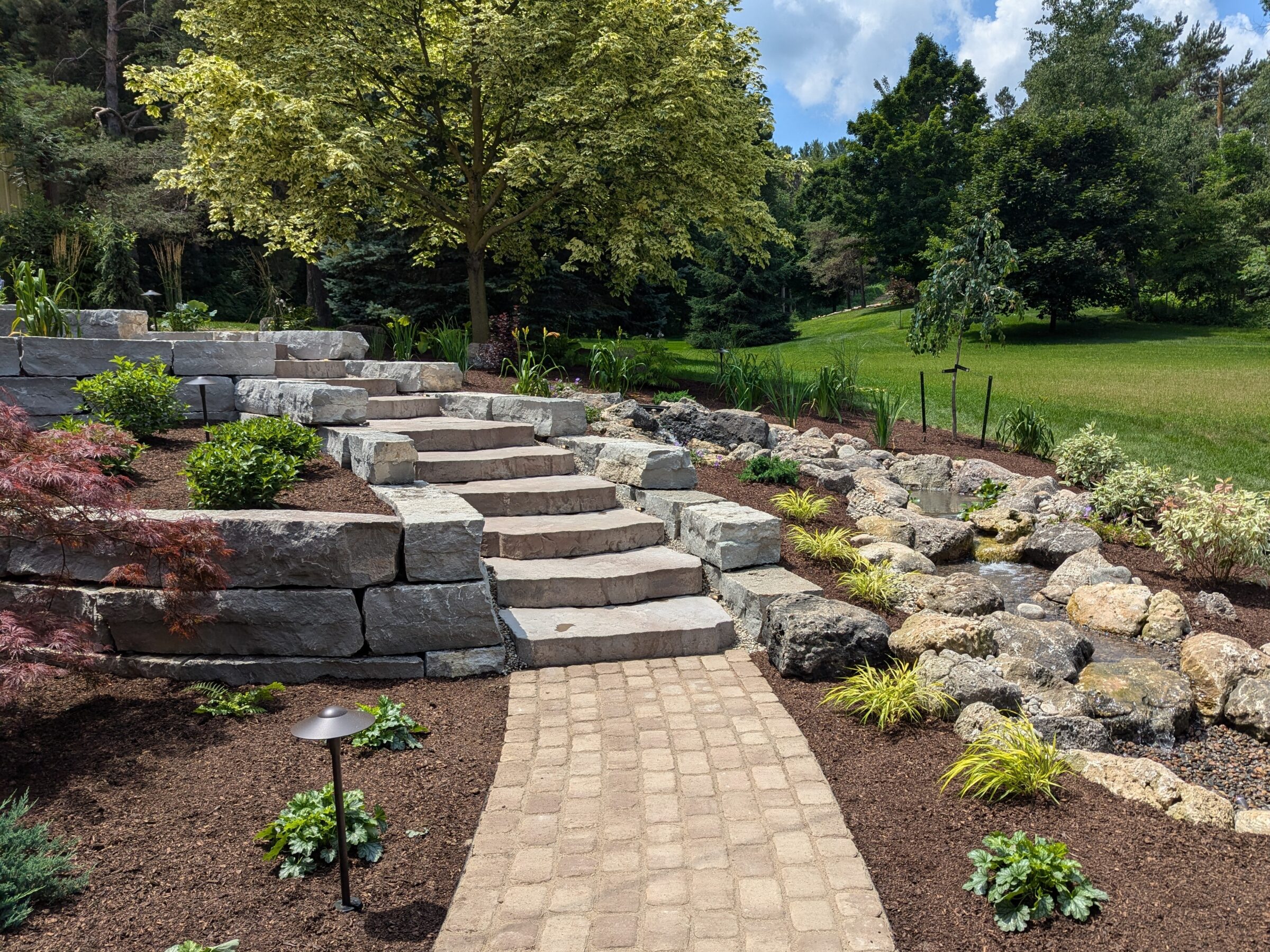Recognizing the Comprehensive Scope of Functions in Expert Landscaping Services
The comprehensive extent of expert landscaping services includes a range of basic aspects. It includes landscape design concepts, plant option, and hardscaping features. Additionally, it deals with watering systems and upkeep methods. Each facet plays an essential function in producing practical and cosmetically pleasing outdoor spaces. Comprehending just how these components interact can disclose much regarding the art and scientific research of landscaping. The journey right into this intricate field is simply starting.
Landscape Design Principles
Reliable landscape style principles are vital for developing harmonious outdoor rooms that boost both visual charm and capability. These concepts direct the arrangement of aspects within the landscape, guaranteeing a natural visual experience. Trick components consist of equilibrium, which distributes visual weight equally; proportion, which connects the size of numerous aspects to every various other and the space; and unity, which develops a sense of wholeness via regular styles and materials.
Emphasis guides interest to focal factors, while rhythm develops movement with rep of style features. The efficient use line can create pathways and lead the eye with the landscape. On top of that, understanding the site's topography, climate, and existing attributes is vital for integration with the surrounding environment. By adhering to these fundamental concepts, landscape developers can craft rooms that not just look enticing yet also serve their intended function, improving the total experience for customers.
Plant Selection and Installment
In the domain of professional landscaping, plant selection and setup play a critical role in accomplishing a flourishing garden - landscaping. Stressing native plant benefits, seasonal factors to consider, and the specific soil and sunshine demands of each species ensures a sustainable and cosmetically pleasing landscape. Careful planning in these areas not just improves biodiversity but additionally promotes long-term ecological health and wellness
Indigenous Plant Advantages
Why should homeowners take into consideration indigenous plants for their landscape design jobs? Native plants supply countless advantages that enhance both appearances and ecological sustainability. They are well-adapted to regional environments, requiring less water and maintenance compared to non-native varieties. This resilience minimizes the need for chemical fertilizers and chemicals, advertising a healthier ecosystem. Furthermore, native plants supply environment and food for regional wild animals, including pollinators, which can boost biodiversity in property locations. Their knowledge with local dirt and weather condition problems likewise leads to much better development prices and durability. By selecting native plants, house owners not only produce aesthetically enticing landscapes but additionally add to environmental preservation, making a favorable impact on their local environment. Native plants represent a smart choice for landscaping projects.
Seasonal Plant Considerations
Home owners who have welcomed native plants in their landscaping can additionally enhance their outside rooms by considering seasonal plant choices. By incorporating plants that grow in specific seasons, they can produce vibrant and aesthetically appealing landscapes throughout the year. Spring may usher in vivid flowers like daffodils and tulips, while summer season can showcase lavish foliage and vibrant perennials. Autumn introduces a combination of cozy tones with goldenrods and asters, while winter can be highlighted with evergreens and ornamental yards for structure. Specialist landscaping companies usually advise picking plants that not just complement existing native species but also provide year-round interest and assistance neighborhood wild animals. This thoughtful approach to seasonal plant selection guarantees a consistently evolving and sustainable garden atmosphere.
Soil and Sunlight Requirements
Successful landscaping hinges on recognizing the specific soil and sunlight needs of plants. Various varieties grow under differing problems, needing a cautious evaluation of both elements during the selection procedure (landscaping). Soil types, such as sandy, clay, or loamy, impact drainage, nutrient accessibility, and origin development. Furthermore, pH degrees can impact plant wellness, necessitating soil testing to determine suitability. Sunlight requirements vary significantly; some plants prosper completely sunlight, while others choose partial or complete color. A specialist landscaper thinks about these elements to guarantee peak development and aesthetic charm. By aligning plant selections with the environment's particular characteristics, landscapes can achieve sustainability, resilience, and aesthetic consistency, eventually causing successful plant facility and long-term upkeep
Hardscaping Features and Construction
While landscape design typically stimulates images of lush greenery and dynamic blossoms, hardscaping functions play an important function in specifying outdoor spaces. These elements, that include outdoor patios, sidewalks, keeping wall surfaces, and attractive stonework, provide structure and capability to yards and yards. Hardscaping makes use of materials such as concrete, stone, timber, and brick, permitting for diverse designs that complement the all-natural landscape.
The construction of hardscaping functions calls for mindful preparation and implementation to ensure durability and aesthetic appeal. Experts assess website problems, drain, and spatial partnerships to create natural exterior environments. Appropriate installment strategies are critical, as they stop issues like disintegration and shifting gradually.
Incorporating hardscaping not only boosts the visual passion of a building however additionally facilitates outside activities, making it a fundamental element of extensive landscaping services. Ultimately, thoughtful hardscaping adds to both the performance and beauty of outdoor spaces.
Watering Solutions and Water Monitoring
Effective watering systems and water management are crucial components of professional landscaping, as they ensure that plants receive the essential hydration for suitable growth. These systems can vary from easy drip watering arrangements to innovative automated sprinkler systems, designed to fulfill the details requirements of varied landscapes. Proper water management not only enhances water use, decreasing waste, but also boosts plant health and decreases condition dangers.
Landscaping specialists examine numerous factors, including soil kind, plant species, and regional climate, to establish customized irrigation services. Furthermore, integrating rainwater harvesting methods can even more enhance sustainability and performance (Read More). Regular upkeep of watering systems is vital to keep functionality and protect against leaks, which can cause water loss and raised prices. Eventually, a well-designed watering system plays a critical role in protecting the visual charm of exterior rooms while promoting ecological stewardship within expert landscaping methods
Yard Treatment and Upkeep Methods
Lawn care and maintenance strategies are fundamental for attaining a lush, healthy and balanced lawn that boosts the total landscape. These strategies encompass numerous techniques targeted at promoting excellent growth and visual charm. Regular mowing is important, as it urges thick, even growth while avoiding weeds from establishing. Furthermore, appropriate fertilization provides necessary nutrients, with applications customized to the particular grass type and soil problems.
Watering techniques ought to concentrate on deep, infrequent watering to motivate origin growth, while oygenation improves soil structure and advertises nutrition absorption. Bug and disease administration is likewise essential; determining problems early enables for effective therapies that decrease damage.
Overseeding can invigorate damaged or thin grass, boosting density and color. By implementing these targeted lawn care methods, landscaping specialists can guarantee that backyards remain lively and healthy throughout the periods, greatly contributing to the overall elegance of the property
Seasonal Landscape Treatment and Upkeep
As the periods modification, appropriate landscape treatment becomes essential for maintaining the health and appeal of outdoor rooms. Each season offers unique obstacles and requirements. In spring, landscape specialists concentrate on pruning, planting, and feeding to encourage growth. Summer season needs routine watering, weed control, and bug administration to safeguard newly established plants.
Fall requires the prep work of yards for winter season, consisting of mulching, leaf elimination, and the growing of bulbs for the next springtime. In addition, winter season care involves shielding prone plants from frost and guaranteeing that hardscapes are useful and secure.
Throughout the year, seasonal landscape upkeep guarantees that outside areas continue to be visually attractive and healthy and balanced. Professional services can provide tailored upkeep plans that adjust to the certain needs of each period, allowing homeowner to appreciate vibrant landscapes year-round. On the whole, seasonal care is a vital facet of expert landscape design that advertises longevity and aesthetic value.
Lasting Landscaping Practices
An expanding number of homeowner are accepting lasting landscaping practices to produce eco-friendly outside spaces. These techniques concentrate on preserving sources, improving biodiversity, and minimizing environmental influence. Indigenous plants are frequently picked for their low water demands and compatibility with local ecosystems, lowering the demand for chemical plant foods and More Bonuses chemicals. Rain gardens and permeable paving are utilized to take care of stormwater overflow, advertising groundwater recharge and decreasing disintegration.
Additionally, sustainable landscape design includes natural gardening techniques that prioritize soil wellness and advertise all-natural pest control. Efficient watering systems, such as drip irrigation and rainwater harvesting, aid optimize water usage. Additionally, landscape developers increasingly support for the use of recycled products, such as recovered wood and rocks, to decrease waste. By embracing these sustainable methods, residential or commercial property owners not only contribute to environmental preservation however likewise develop aesthetically pleasing atmospheres that can grow with minimal maintenance.
Often Asked Inquiries
How much time Does a Landscape Design Task Normally Require To Full?
Generally, a landscaping job can take anywhere from a couple of days to a number of weeks to finish, depending on the project's intricacy, layout, and dimension needs. Read More. Aspects such as weather condition and resource availability also affect timelines
What Variables Impact the Price of Landscaping Services?
Various aspects affect landscaping solution costs, including project dimension, design intricacy, material top quality, labor costs, geographic place, and seasonal demand. Each component contributes distinctly to the overall economic demands of a landscape design project.
Are Landscape Design Solutions Available Year-Round?
Landscape design services are normally available year-round, although schedule may differ based on area, seasonal climate condition, and specific service offerings. Some services could be restricted throughout severe climate or off-peak periods.
Do Landscaping Business Deal Warranties on Their Job?

Can I Design My Landscape Without Specialist Assist?
Yes, individuals can create their landscapes without specialist help. Nonetheless, they may do not have expertise in plant selection, design, and environmental considerations, possibly leading to much less reliable designs that could call for costly modifications later on.
